- Places
- Plans
- Itineraries
- Experiences
The top culinary adventures in Italy

Yes, Elizabeth Gilbert's book title is an inspired one—but everybody knows that an Italian mamma would keep it much simpler: "Eat, Eat, Eat!"
Ms. Gilbert may have found fulfillment with a gustatory, spiritual, and romantic romp through 12 time zones (can't be bad for one's self-image to write a runaway best-seller or be played by Julia Roberts in the movie, either).
For some of us, though, simply the culinary indulgences of Italy will do nicely, thank you very much.
So if you don't plan on incorporating India and Bali into your own "Eat, Pray, Love"–inspired vacation and prefer just sticking to Italy, here are some of Italy's most memorable food experiences.
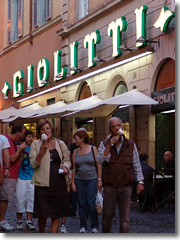
Ice cream cones from Rome's storied Gelateria Giolitti.
It is churned, not whipped (as is most traditional American ice cream), so it is far denser, giving it a richer mouth feel. Gelato also is not as laden with sugar and cream, so the subtle tastes of its flavoring comes through much better than they do in ice cream.
Like Elizabeth Gilbert, you can pay homage to the great San Crispino in Rome—though there are plenty of other older, excellent gelaterie in Rome as well, such as Giolitti, pictured to the left. (Taste-test time!)
Don't forget to try the Florentine variation on this sweet treat—many claim the best gelato in Italy comes from Florence.
And, as a bonus, there's a gelateria in Florence called Carabé that specializes in the light fruit- and nut-focused gelati of Sicily (and which is, handily, less than two blocks from Michelangelo's David)... » more
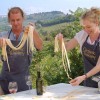 Rather than just taking home from your next trip tales of how incredible the food was, why not return with the skills to re-create all those great Italian meals in your own kitchen?
Rather than just taking home from your next trip tales of how incredible the food was, why not return with the skills to re-create all those great Italian meals in your own kitchen?
Cooking schools and cooking classes—whether for an afternoon or a full week—are becoming all the rage among travelers in Italy, and it's not hard to see why.
You're getting the kind of genuine cultural insight that visiting no number of churches and museums could ever give, you're engaging with the locals on something about which they are truly passionate, and you're gaining a new skill (or at least new recipes to add to your repertoire).
And, of course, you get to eat all your mistakes (mmmm—mistakes)... » more
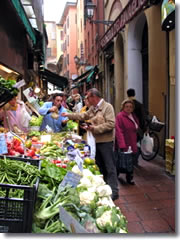 The street market on Via Drapperie in Bologna, Italy.Every Italian region is justifiably proud of its own cuisine—considers it in fact to be the best in the whole world. But force an Italian to name just one region, one region in all of Italy, that's known above all for its culinary prowess and he'll admit: it's Emilia-Romagna.
The street market on Via Drapperie in Bologna, Italy.Every Italian region is justifiably proud of its own cuisine—considers it in fact to be the best in the whole world. But force an Italian to name just one region, one region in all of Italy, that's known above all for its culinary prowess and he'll admit: it's Emilia-Romagna.
In Modena they make the world's best balsamic vinegar; in Parma the best aged sheep's cheese (parmigiano) and cured ham (prosciutto di Parma). And the regional capital? Ah, you must mean Bologna the Fat, a bustling city of arcaded streets and food markets that blew Gilbert away with its culinary diversity.
Bologna is the birthplace of tortellini—little rings of pasta stuffed with savory meats and gooey cheeses. This is the land that invented the ragú sauce atop tagliatelle alla Bolognese. The local cured meat named mortadella remains so wildly popular the world over (particularly in school lunches) that most cultures call it simply "bologna"—or, if you prefer, baloney.
Life in Bologna centers around the kitchen. These people just love to eat—and eat well. To get under the skin of this city, take a morning to explore the gastronomic side of Bologna: its street markets, wine bars, fourth-generation grocers, traditional pasta makers, and storied chocolatiers.
Start early, around 8am, to mingle with the market workers, professional trattoria chefs, and home-kitchen master chefs out doing their morning shopping... » more

Julia Roberts samples Neapolitan pizza in Eat Pray Love (Sony Pictures, 2010). (Photo by Francois Duhamel.)Naples holds a hallowed place in culinary history as the inventors of mankind's most perfect dish: the pizza. (Back when I was a kid, before the whole "food pyramid" theory ruined my argument, I tried to convince my mother that pepperoni pizza was the ultimate food since it covered all four major food groups: grain, dairy, fruit/veg, and meat. My efforts were unsuccessful.)
Gilbert made a trip down to Naples just to try the pizza—and you would be wise to follow. Every Neapolitan has a favorite pizzeria, as does every visitor who eats in more than one—and, again if you are wise, you will eat in more than one. I'd say you need to try at least four to get a good baseline determination for where to find the best pizza in Naples.
Will it be Pizzeria Brandi, the place that claims to have invented the classic sauce-cheese-basil pizza Margherita in 1889? How about Pizzeria Port'Alba, a bustling pizza joint on a pedestrian street that gets my nod for best margherita? Maybe no-nonsense, bare-bones Pizzeria Trianon da Ciro, a place packed with mostly locals, will be your call. Try those. Ask around for advice on others. You be the judge... » more
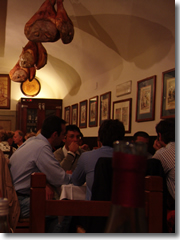 If you are looking for that archetypal Italian feast, the one that lasts for hours and has more courses than you can count, make a reservation at Il Latini. Sure, there are thousands of places in Italy where you can indulge in the marathon four-hour dinner, but Il Il Latini is in the heart of Florence, and it is the old standby for that classic Tuscan full meal—especially since Uncle Narciso and his staff don't really want to let you get away with ordering anything less than the full feast.
If you are looking for that archetypal Italian feast, the one that lasts for hours and has more courses than you can count, make a reservation at Il Latini. Sure, there are thousands of places in Italy where you can indulge in the marathon four-hour dinner, but Il Il Latini is in the heart of Florence, and it is the old standby for that classic Tuscan full meal—especially since Uncle Narciso and his staff don't really want to let you get away with ordering anything less than the full feast.
You can tell this classic trattoria is good due to the scrum of people waiting patiently out front for it to open its doors at 7:30pm (I prefer to come for a later seating around 9pm). Even with a reservation, it might take a while to get you seated.
Yes, there are loads of tourists inside, but there are loads of Florentines as well, everyone puzzled together at long communal tables under pendulums of prosciutto hamhocks hanging from the wood rafters. They have all come for the Latini feast—appetizers of crostini, hearty plates of pasta or bowls of ribollita soup, heaping platters of grilled meats, veggies, biscotti, and all the wine, water, and grappa you can drink—all for one set price that's a bit of a splurge but won't break the bank... » more
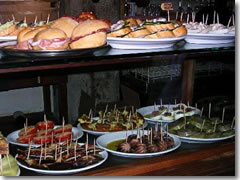
Cicchetti at Cantina Do Mori in Venice.Cicchetti are Venetian tapas—finger foods such as calamari rings, fried olives, potato croquettes, grilled polenta squares, stuffed tomatoes, grilled vegetables, pâtés on rounds of bread, and pretty much anything that can be speared on a toothpick—traditionally washed down with an ombra (shadow), the Venetian nickname for a small glass of wine.
Venice has countless cafes and neighborhood bars called bacari where you can order a selection of cicchetti, a panino (sandwich on a roll), or a toast (grilled ham-and-cheese sandwich). All of the above will cost about €1–€2 if you stand at the bar, or as much as double that if you sit at a table.
Among my favorites are Cantina Do Mori, with copper pots dangling from the rafters and upended barrels serving as standing tables; and Enoteca Già Schiavi, alongside a canal with one of the tastiest and most sophisticated spreads of snacks... » more
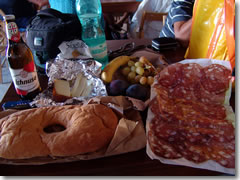
A picnic I had on Isola Asinara in Sardegna (you can tell it was Sardegna form the weird holed bread and the bottle of Ichnusa beer).A bottle of Chianti, a crusty loaf of bread, some fresh fruit, creamy local cheeses and spicy salamis, salty prosciutto, tangy olives, and a flaky pastry to top it all off makes a fabulous meal. Stop at a half dozen little neighborhood shops, and maybe stop by the local market, and for less than $10 per person you can put together a feast worthy of a Roman emperor.
This is not just some budget fallback to help save money. Picnicking in Italy can be as much fun and unforgettable as a meal in the finest restaurant. Even with all the restaurants I eat in just to do my job, one of my most memorable Italian meals ever remains a late-night picnic in a hotel room in Tuscany with my parents.
• Picnic supplies in Rome
• Picnic supplies in FlorenceI have broken bread (focaccia, actually) with my Boy Scout troop on a patch of grass overlooking the Colosseum in Rome, enjoyed the world's freshest mozzarella direct from the farm in the fields of southern Campania, dined gloriously alone on a panino and some clementines atop a wall overlooking the vineyards of Tuscany, had members of a Italian hiking group compete to share the best of their brown-bagged bounty with me on a Sicilian hilltop near some Byzantine ruins (after which we picked almonds off a tree and cracked them open with stones), and sat with a friend on the grassy banks above the Brenta Canal—the villa-peppered country escape of Renaissance doges just outside of Venice—and watched the boats glide by as we munched sandwiches, shared a bottle of fizzy Lambrusco wine, and ate an entire watermelon... » more
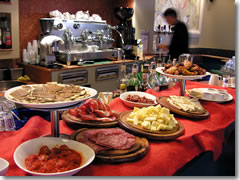 Apertivi ("aperitifs") is a simple idea: basically, it's happy hour with free nosh. Starting at the end of the daily see-and-be-seen passeggiata strolling hour(s) between the end of the workday and the start of dinner, many bars and cafes in town will lay out stuzzichini (little snacks) to draw in patrons.
Apertivi ("aperitifs") is a simple idea: basically, it's happy hour with free nosh. Starting at the end of the daily see-and-be-seen passeggiata strolling hour(s) between the end of the workday and the start of dinner, many bars and cafes in town will lay out stuzzichini (little snacks) to draw in patrons.
These aperitivi usually run from 7pm to 9pm or so. The phenomenon started in Northern Italy (most people say in Milan, but I swear I encountered it in Turin years before I saw it in Milano), but happily has recently spread to Rome and other Italian cities as well.
In some cases, the fare is just basic bar snacks (olives, nuts, and salty crunchy things in the chips/crisps family), but an increasing number of downtown bars—especially trendy ones—load down the bar or long tables with dozens upon dozens of mouth-watering canapés, tapas, and tidbits.
You'll find trays piled high with salamis and cheeses, tiny pizzas, various pates and cured meats atop rounds of bread, fried rice balls gooey with mozzarella, grilled veggies, wedges of stuffed frittate (a cross between an omelet and a quiche), pretty much any food you can spear on a toothpick, and all sorts of pastries, tortes, and cookies.
Bar-hop your way from one cafe to another and you can easily make a full meal out of it... » more

Not only are agriturismi an excellent way to get a break from the big art cities and get an up-close and personal look at the rural heart of Italy, but you usually get the friendliest of family welcomes, and they're affordable—often charging anywhere from 30% to 80% the price of a typical hotel.
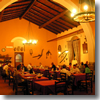 Even better new is this: More and more agriturismi are opening restaurants featuring wonderfully huge, cheap, and hearty home-cooked dinners, usually four or five hearty courses of food fresh from the fields and pastures just outside your window and often ringing it at a mind-blowingly inexpensive €30 to €45 per person for everything, including wine (table wine, of course, but one produced on-site, at a neighbor's, or at least by a member of the extended family).
Even better new is this: More and more agriturismi are opening restaurants featuring wonderfully huge, cheap, and hearty home-cooked dinners, usually four or five hearty courses of food fresh from the fields and pastures just outside your window and often ringing it at a mind-blowingly inexpensive €30 to €45 per person for everything, including wine (table wine, of course, but one produced on-site, at a neighbor's, or at least by a member of the extended family).
Even those agriturisms that don't offer a restaurant for dinner almost always do breakfast—usually included in the rates and almost always excellent: a farmer's spread of freshly baked breads and pastries, homemade jams and marmalades, milk straight from the cow (so to speak), fresh fruits, and more... » more
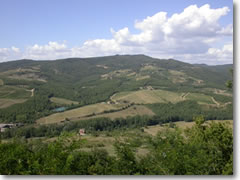 OK, not strictly food-oriented, but wine is an integral part of any Italian meal, so why not go right to the source and see where it comes from—sampling all the vino as you go? There are hundreds of wine regions in Italy, dozens of which are world-famous, but if you can pick only one, it has to the be Chianti Classico.
OK, not strictly food-oriented, but wine is an integral part of any Italian meal, so why not go right to the source and see where it comes from—sampling all the vino as you go? There are hundreds of wine regions in Italy, dozens of which are world-famous, but if you can pick only one, it has to the be Chianti Classico.
The 30-mile stretch of the Chianti hills between Florence and Siena comprises one of the planet's most famous wine-producing regions.
The steep slopes are cloaked in terraced rows of vines and peppered with medieval castles and cypress-shrouded abbeys.
The narrow valleys are laced with tiny rivers along which are sprinkled small market towns: Greve in Chianti (the unofficial capital of the Chianti), Radda in Chianti, Gaiole in Chianti.
This idyllic landscape is also peppered with wineries, many of which open their doors to the public and invite you in to sample the goods.
(Also, while I said this one wasn't about the food, many wineries do put out tables of nibbles for visitors, and increasingly many are opening full restaurants, such as the one at Hotel Castello di Fonterutoli)... » more
Si mangia!
Share this page
Search ReidsItaly.com